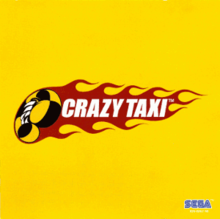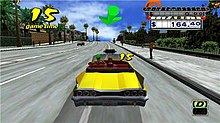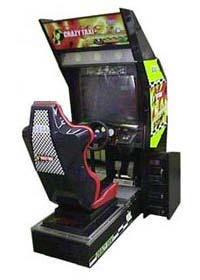Crazy Taxi (video game): Difference between revisions
→Development and marketing: right align per MOS:IMAGES which dictates images should alternate sides where possible |
No edit summary |
||
| Line 11: | Line 11: | ||
|genre=[[Racing video game|Racing]], [[Action game|Action]], [[Open world|Sandbox]] |
|genre=[[Racing video game|Racing]], [[Action game|Action]], [[Open world|Sandbox]] |
||
|modes=[[Single-player]] |
|modes=[[Single-player]] |
||
|ratings={{vgratings|ESRB= |
|ratings={{vgratings|ESRB=RP(Rating Pending)|ELSPA=3+|ACB=PG|PEGI=3+}} |
||
|platforms= |
|platforms=[[Nintendo GameCube]], [[Microsoft Windows]],[[OnLive]] |
||
|media=[[GD-ROM]], [[DVD-ROM]], [[Nintendo optical disc]], [[CD-ROM]], [[Digital distribution|Digital download]], [[Universal Media Disc|UMD]], [[cloud computing]] |
|media=[[GD-ROM]], [[DVD-ROM]], [[Nintendo optical disc]], [[CD-ROM]], [[Digital distribution|Digital download]], [[Universal Media Disc|UMD]], [[cloud computing]] |
||
|arcade system=[[Sega NAOMI]]<ref name="arcade cabinet" /> |
|arcade system=[[Sega NAOMI]]<ref name="arcade cabinet" /> |
||
Revision as of 07:56, 1 September 2012
| Crazy Taxi | |
|---|---|
 Cover art | |
| Developer(s) | Hitmaker Strangelite (PC) Sega Studios (PlayStation 3, Xbox 360)[2] |
| Publisher(s) | Sega Acclaim (PlayStation 2, Gamecube) Activision (Microsoft Windows) |
| Series | Crazy Taxi |
| Platform(s) | Nintendo GameCube, Microsoft Windows,OnLive |
| Release | 1999
|
| Genre(s) | Racing, Action, Sandbox |
| Mode(s) | Single-player |
| Arcade system | Sega NAOMI[3] |
Crazy Taxi is a open world racing video game developed by Hitmaker (Sega AM3) and published by Sega.[4] It is the first game in the Crazy Taxi series. The game was first released in arcades in 1999 and was ported to the Dreamcast in 2000. Subsequently, it was ported to the PlayStation 2 and Nintendo GameCube by Acclaim in 2001, and then Microsoft Windows in 2002. The game was released on November 16, 2010 for the PlayStation Network and on November 24, 2010 for the Xbox Live Arcade. It is featured on the Dreamcast Collection. A port for the Zeebo is also planned, though no release date has been set.
Reception to Crazy Taxi has been mostly positive and it became one of the few Sega All Stars. It has also earned Greatest Hits status on PlayStation 2 and Player's Choice status on GameCube. Sega followed up on the success of Crazy Taxi by making a sequel, Crazy Taxi 2 for the Dreamcast, which included several gameplay changes. It would also be bundled with Crazy Taxi 2 in Crazy Taxi: Fare Wars, and later be bundled with other Dreamcast hits in Dreamcast Collection. Crazy Taxi 3: High Roller was released for the Xbox on July 23, 2002, and later released as a PC title in 2004.
Gameplay

The main objective of the game is to pick up customers and take them to their chosen destination as quickly as possible. Along the way, money can be earned by performing stunts such as near misses with other vehicles.[5] The player is directed to a destination by a large green arrow at the top of the screen. The arrow does not adjust based on obstacles, but rather points in the general direction of the destination. Once the player arrives near the destination, they must stop within a specified zone. When the destination is reached, that customer's fare is added to the player's total money earned. Ratings are then awarded depending on how long the player took to complete the journey.[6] If the customer's timer runs out before the player reaches the destination the customer jumps from the taxi.
Players can select three, five or ten minute settings, or the Arcade Rules used in the original coin-op version of the game.[6] In the three time-limited settings, play continues for the designated period of time, after which the cab automatically stops and no more points can be scored. Under Arcade Rules, the player starts with an initial time limit of one minute, which can be extended through time bonuses earned for quick deliveries. Console versions of the game also feature a mode known as Crazy Box, a set of minigames that feature challenges such as picking up and dropping off a number of customers within a time limit, bowling using the taxi as a ball, and popping giant balloons in a field.[7]
The arcade version of the game includes one stage, and an additional "Original" stage was added for the console versions. Both stages are based in sunny coastal California locales, with steep hills and other strong similarities to San Francisco. The player has a choice of four drivers and their cabs, each of whom has slightly different attributes.
Development and marketing

The arcade game was developed by Hitmaker as a variation from then-current arcade titles. The Crazy Taxi cabinet ran on Sega Naomi hardware.[3] It was originally released in arcades as a sit-down machine.[8] An upright version was later released.[9] Over the next few years, the game would be ported to the Dreamcast, GameCube, PlayStation 2 and Microsoft Windows. The ratings board for South Korea revealed on June 1, 2010 that the game was rated for release on Xbox Live Arcade.[10] On June 10, 2010, Sega officially announced Crazy Taxi would be one of several Dreamcast titles to be released for the PlayStation Network and Xbox Live Arcade, and that it would be available in Fall 2010.[11] These ports originally were to force a 4:3 aspect ratio, with widescreen monitors showing blue bars on either side of the screen.[12] In October 2010 it was announced that Crazy Taxi would feature full widescreen support.[13] The game is a port of the Dreamcast version, including both the original arcade and the Dreamcast-exclusive level.[13] The PlayStation Network port was released November 23, 2010, while the Xbox Live Arcade version was released the following day.Cite error: The <ref> tag has too many names (see the help page).
Sega applied for and was awarded U.S. Patent 6,200,138–"Game display method, moving direction indicating method, game apparatus and drive simulating apparatus" – in 2001.[14] The mechanics in the "138 patent" describe an arcade cabinet similar to Sega's previous arcade game Harley-Davidson & L.A. Riders (1997),[15] but also describe the arrow navigation system and pedestrian avoidance aspects that were used in Crazy Taxi.
Crazy Taxi producer Kenji Kanno noted that the time extension on gameplay was a breakaway of the current "100 yen for 3 minutes" that persisted at the time for arcade games, and rewarded players with longer playing times by performing well in the game.[7] In addition to providing a game that could be played in short sessions, Kanno wanted a game to explore the "daily life and routine" of a taxi driver.[16] In the development of the Dreamcast version of the original arcade game, the developers included a larger map in addition to the arcade one, as to create a feeling of "being lost" and allowing home console players to have fun "learning the town".[7] Mini-games were developed for this version as to "let the player play longer if he improve[d] skill" by offering challenges that were both fun and educational. Over one hundred different ideas for mini-games were developed by the team but then pared down for the Crazy Box mini-game challenges for the game.[7]
Crazy Taxi is also notable for its soundtrack featuring the bands Bad Religion and The Offspring, who provided all of the tracks for the arcade, Dreamcast, PlayStation 2 and GameCube ports.[5] The PC featured an entirely new soundtrack, omitting the original bands in favor of music from Pivit, Too Rude, and Total Chaos.[17] The PlayStation 3 and Xbox 360 versions of Crazy Taxi also exclude the original bands, providing an original soundtrack for the ports.[12] Custom soundtracks can also be used on the PlayStation 3 and Xbox 360 via their system firmware.
In addition to generic destinations such as the city's police station, rail terminal and lookout point, passengers may also request to be taken to Pizza Hut, Tower Records, the FILA sportswear store, Levi's store or Kentucky Fried Chicken.[6] Crazy Taxi also featured vans on the roads with the WOW! logo on the side. Each of these chains are modeled as a location in the game. This is considered one of the most prominent examples of product placement in video gaming history.[18] These establishments have been replaced with generic businesses in later versions due to licensing difficulties.[12][19]
Reception
| Aggregator | Score | |||||
|---|---|---|---|---|---|---|
| Dreamcast | GC | PC | PS2 | PS3 | Xbox 360 | |
| GameRankings | 90.27%[32] | 71.09%[28] | 55.67%[29] | 79.07%[30] | 63.21%[31] | 61.75%[33] |
| Metacritic | 69/100[34] | 80/100[35] | 60/100[36] | 59/100[37] | ||
| Publication | Score | |||||
|---|---|---|---|---|---|---|
| Dreamcast | GC | PC | PS2 | PS3 | Xbox 360 | |
| Famitsu | 34/40[21] | 30/40[20] | ||||
| GameSpot | 8.7/10[24] | 4.9/10[22] | 5.4/10[17] | 7.8/10[23] | ||
| IGN | 9.6/10[6] | 6.9/10[25] | 7.1/10[26] | 6/10[27] | 6/10[27] | |
Most versions of Crazy Taxi were generally well received by critics. The Dreamcast version of Crazy Taxi was critically acclaimed, averaging 90.27% at video game aggregate site GameRankings based on 36 reviews.[32] Subsequent ports of the game have suffered a trend of declining average scores. The PlayStation 2 port averaged 79.07% at GameRankings and 80/100 at Metacritic, respectively.[30][35] The next port for the GameCube scored lower, with aggregate scores of 71.09% and 69/100.[28][34] The PC port was the poorest rated of the initial ports, scoring an average of 55.67% at GameRankings.[29] Sales for the game were generally high, with the Dreamcast version being the second largest selling Dreamcast game in the United States in Template:Vgy, selling nearly 750,000 units,[38] and both the Dreamcast and PlayStation 2 versions selling in excess of one million units overall.[38] Xbox Live Arcade sales for 2011 were high with the game moving nearly 100,000 units.[39]
Critics generally praised the overall gameplay. An IGN staff member said "I can't stress enough how addictive this game is."[6] Of the Dreamcast port Game Revolution's reviewer stated "a great arcade game became a good home game."[5] They further noted the game's high difficulty, and added that while the game was difficult it was not frustrating.[5] Micheal Goncalves of PALGN added that the game was either a "love or hate" title, adding "if you love it, you will cherish the game and play it to your hearts content."[40] Goncalves also pointed out that the game featured occasional pop up and clipping.[40] Reviews were split across the releases in regards to the game's soundtrack. PALGN cited Bad Religion and The Offspring as a high point of the game,[40] while Game Revolution felt that the tracks were repetitive.[5] GameSpot reviewer Jeff Gerstmann felt that the soundtrack was subjective to personal preference, stating "you'll either want to crank the volume up or turn the music all the way down."[23] In a review for the PC version's altered soundtrack, fellow GameSpot reviewer Andrew Park felt that the new music was fitting for the game.[17]
IGN's Hilary Goldstein called the Xbox Live Arcade release "a mad dash of fun", adding "there's almost no depth to Crazy Taxi, but that's just fine."[27] Goldstein praised the fact that the port stayed true to the original source. However he felt that the lack of the original soundtrack "kills half the reason to pick Crazy Taxi up again."[27] Criticism also pointed to the lack of visual updates such as higher resolution models and textures.[27] GamePro's Dave Rudden also lauded the fact that the port played faithfully to the original. Rudden echoed Goldstein's comments in regards to poor visuals, stating it had "ugly character models and boxy traffic cars."[41] Robert Workman from GameZone praised the game for sticking to its Sega roots; he stated "Crazy Taxi isn’t just a nostalgic trip, but also a wondrous stress reliever and an all-around entertaining game."[42]
Legacy
Crazy Taxi's success prompted Sega to produce multiple sequels. In 2001, Crazy Taxi 2 was released, followed by Crazy Taxi 3: High Roller in 2002. THQ would publish the Graphic State Games developed Crazy Taxi: Catch a Ride in 2003, the only title for the Game Boy Advance. Crazy Taxi: Fare Wars, a compilation of Crazy Taxi and Crazy Taxi 2 was released in 2007 for the PlayStation Portable, and is the newest title in the series.
Crazy Taxi and its sequels have also prompted several games which clone its core gameplay. The Simpsons: Road Rage was the first of these titles, released in 2001. In 2003, Sega filed a lawsuit against Fox Interactive, Electronic Arts, and Radical Entertainment.[43] Sega claimed that the game was a patent infringement of Crazy Taxi. The case, Sega of America, Inc. v. Fox Interactive, et al., was settled in private for an undisclosed amount.[44] The poorly received Emergency Mayhem for the Wii utilizes the same core gameplay of the Crazy Taxi series, but adds additional elements in regards to driving emergency response vehicles.[45]
References
- ^ a b Gantayat, Anoop. "..Crazy Taxi picking up fares Nov. 23 on PSN, Nov. 24 on XBLA". Joystiq. Retrieved 2010-10-14.
- ^ Gantayat, Anoop (2010-06-30). "Sega Considering Saturn Download Releases". andriasang.com. Retrieved 2010-10-05.
- ^ a b "DCTP - SEGA's Naomi Technical Overview". segatech.com. Retrieved 2010-10-04.
- ^ "Top 25 Racing Games... Ever! Part 1". Retro Gamer. 16 September 2009. Retrieved 2011-03-17.
- ^ a b c d e Collin (2000-02-01). "Crazy Taxi - DreamCast". Game Revolution. Retrieved 2010-10-05.
- ^ a b c d e IGN Staff (2000-01-28). "Crazy Taxi - Dreamcast". IGN. Retrieved 2010-10-05.
- ^ a b c d IGN Staff (2000-02-04). "The "Crazy" Interview with SoJ's Kenji Kanno". IGN. Retrieved 2007-08-17.
- ^ "Crazy Taxi". Sega. Retrieved 2010-10-05.
- ^ "Crazy Taxi Arcade Machine - Driving Machines - Arcade Machines". arcade-game-sales.com. Retrieved 2010-10-05.
- ^ Spencer (2010-06-01). "Crazy Taxi And Sonic Adventure Rolling On To Xbox 360 In Korea". siliconera.com. Retrieved 2010-10-05.
- ^ ArchangelUK (2010-06-10). "Dreamcast Games To Make Digital Return". Sega. Retrieved 2010-10-05.
- ^ a b c Fletcher, JC (2010-06-20). "Sonic Adventure on PSN and XBLA won't venture outside of 4:3 aspect ratio". Joystiq. Retrieved 2010-10-05.
- ^ a b Tolito, Stephen (2010-10-12). "Crazy Taxi Port Is Faithful But Wider". Kotaku. Retrieved 2010-10-12.
- ^ "U.S. Patent 6,200,138". U.S. Patent Office. 2001-03-13. Retrieved 2010-10-04.
- ^ "Harley Davidson L.A. Riders". Sega. Retrieved 2010-10-04.
- ^ "Video interview with Kenji Kanno". IGN. 2007-08-03. Retrieved 2007-10-31.
- ^ a b c Park, Andrew (2002-10-14). "Crazy Taxi Review". GameSpot. Retrieved 2010-10-05.
- ^ O'Luanaigh, Patrick (2006-04-06). "Book Excerpt: Game Design Complete: Advergaming and Sponsorships". Game Career Guide. Retrieved 2007-08-15.
- ^ Bedigian, Louis. "Catch a ride in full 3D with "Crazy Taxi" for Game Boy Advance". GameZone. Retrieved 2007-08-17.
- ^ プレイステーション2 - クレイジータクシー. Weekly Famitsu. No.915 Pt.2. Pg.90. 30 June 2006.
- ^ ドリームキャスト - CRAZY TAXI (クレイジータクシー). Weekly Famitsu. No.915 Pt.2. Pg.39. 30 June 2006.
- ^ Gerstmann, Jeff (2001-11-20). "Crazy Taxi Review - GameCube". GameSpot. Retrieved 2010-10-05.
- ^ a b Gerstmann, Jeff (2001-05-08). "Crazy Taxi Review - PlayStation 2". GameSpot. Retrieved 2010-10-05.
- ^ Gerstmann, Jeff (2000-01-26). "Crazy Taxi Review - Dreamcast". GameSpot. Retrieved 2010-10-05.
- ^ Fran Mirabella III (2001-11-21). "Crazy Taxi - GameCube". IGN. Retrieved 2010-10-05.
- ^ Zdyrko, David (2001-05-29). "Crazy Taxi - PlayStation 2". IGN. Retrieved 2010-10-05.
- ^ a b c d e Goldstein, Hilary (2010-11-19). "Crazy Taxi Review". IGN. Retrieved 2010-11-24.
- ^ a b "Crazy Taxi for GameCube - GameRankings". GameRankings. Retrieved 2010-10-05.
- ^ a b "Crazy Taxi for PC - GameRankings". GameRankings. Retrieved 2010-10-05.
- ^ a b "Crazy Taxi for PlayStation 2 - GameRankings". GameRankings. Retrieved 2010-10-05.
- ^ "Crazy Taxi for PlayStation 3 - GameRankings". GameRankings. Retrieved 2010-11-24.
- ^ a b "Crazy Taxi for Dreamcast - GameRankings". GameRankings. Retrieved 2010-10-05.
- ^ "Crazy Taxi for Xbox 360 - GameRankings". GameRankings. Retrieved 2010-11-24.
- ^ a b "Crazy Taxi for GameCube Reviews, Ratings, Credits, and More at Metacritic". Metacritic. Retrieved 2010-10-05.
- ^ a b "Crazy Taxi for PlayStation 2 Reviews, Ratings, Credits, and More at Metacritic". Metacritic. Retrieved 2010-10-05.
- ^ "Crazy Taxi for PlayStation 3 Reviews, Ratings, Credits, and More at Metacritic". Metacritic. Retrieved 2010-11-24.
- ^ "Crazy Taxi for Xbox 360 Reviews, Ratings, Credits, and More at Metacritic". Metacritic. Retrieved 2010-11-24.
- ^ a b "US Top 10 Best Selling Console Games in 2000". The Magicbox. Retrieved 2010-10-06.
- ^ Langley, Ryan (2012-01-20). "Xbox Live Arcade by the numbers - the 2011 year in review". Gamasutra. Retrieved 2012-01-23.
- ^ a b c Goncalves, Micheal (2003-01-28). "Crazy Taxi GameCube Review". PALGN. Retrieved 2010-10-06.
- ^ Rudden, Dave (2010-11-19). "Crazy Taxi". GamePro. Archived from the original on 2011-12-01. Retrieved 2010-11-25.
{{cite web}}: Italic or bold markup not allowed in:|publisher=(help) - ^ Workman, Robert (2010-12-30). "Crazy Taxi Review". GameZone. Retrieved 2011-01-02.
- ^ Adams, David (2003-12-05). "SEGA Sues Fox and EA". IGN. Retrieved 2010-10-04.
- ^ "Profile of Robert J. Yorio". Carr & Ferrell LLC. Retrieved 2010-10-04.
- ^ Casamassina, Matt (2008-05-07). "Emergency Mayhem Review". IGN. Retrieved 2010-10-05.
External links
- 1999 video games
- Arcade games
- Comedy video games
- Dreamcast games
- Nintendo GameCube games
- Interactive Achievement Award winners
- PlayStation 2 games
- PlayStation 3 games
- PlayStation Network games
- Racing video games
- Sega-AM3 games
- Video games developed in Japan
- Video games developed in the United Kingdom
- Windows games
- Xbox 360 Live Arcade games
